Garter snakes (Thamnophis species) are part of a genus consisting of 30 species.
They are native to North and Central America. They have a wide diet and are typically found in either humid climates or near bodies of water. Many species are kept in captivity.
One interesting thing to note about the garter snake is that they are known for spending their winter brumation in communal dens.
Once spring arrives, they form mating balls to reproduce. They will then produce live young after a gestation period.
Since these snakes are found over such a wide range and many species are kept in captivity, this is a general guide on how to care for members of the genus.
You also watch your snake to dial in the exact conditions that are right for your pet.
Housing
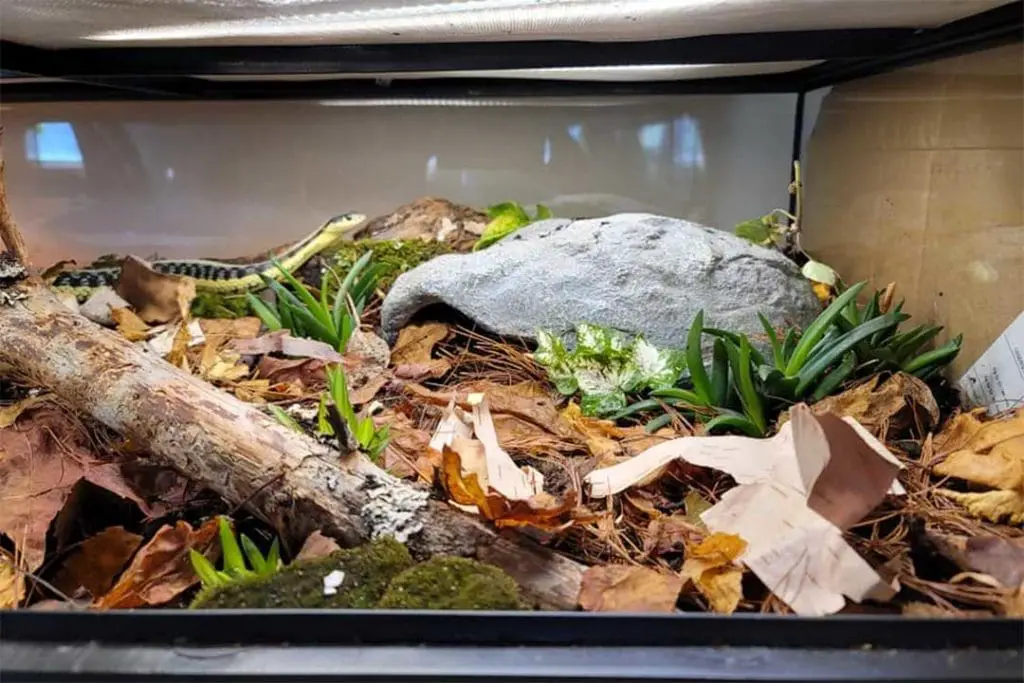
The first step in keeping any reptile is creating a good enclosure. It should ideally feel like a small segment of your snake’s natural habitat.
Aim to offer the snake as many opportunities to practice natural behaviors as possible. You should also be sure to fill the space as much as possible.
This will help your snake feel secure. Garter snakes are typically slim and good at squeezing through the tiniest cracks.
Be sure your snake is secure by making sure any gaps are no larger than the snake’s eyes. If your snake can get its head out past the eyes, it will have no trouble sneaking out.
You should also be sure to offer a big water dish since many garter snakes enjoy swimming and soaking. Be sure not to let the humidity get too high or allow the substrate to become wet since this can cause injuries to your snake.
Enclosure
The biggest part of keeping a garter snake is making sure there are no large gaps and having a good lock. These snakes are slim and can sneak out of very small holes.
You will also want space to offer deeper substrate since they produce lots of waste and enjoy burrowing. You need room for at least 1 inch of the substrate, but deeper is better.
You should also aim to cover the sides if you select a clear enclosure since garter snakes are easily stressed if they feel exposed. Be sure you offer plenty of climbing surfaces and use either fake or real greenery and plenty of hides to keep your snake feeling safe.
Enclosure for Baby & Juvenile Garter Snakes
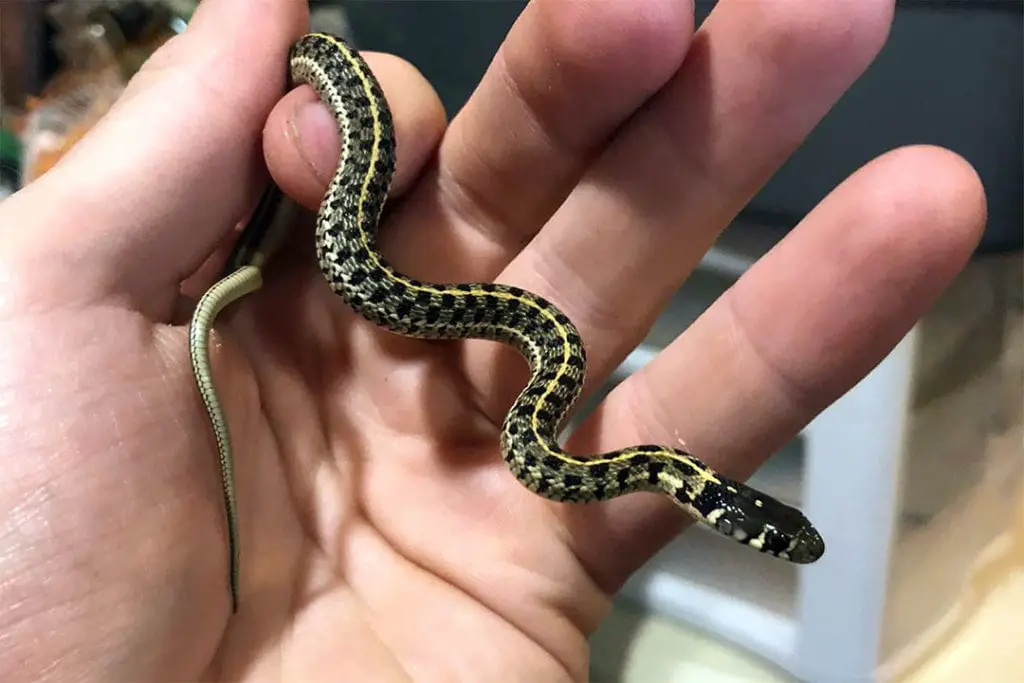
Babies for most species of garter snake are incredibly small. They will do just fine in an 18″x18″x12″ cage until adulthood. The biggest concern for a baby garter snake is keeping them in the enclosure.
Babies are amazing escape artists and can for through tiny gaps.
Be sure you have no large gaps and that the snake cannot push off the ventilation screens to escape.
Be sure you fill up the space very well and use either construction paper or background paper to help make the enclosure feel secure for your snake. Add multiple hides and deep substrate with pieces of bark over a few areas.
This will help your snake feel less exposed. Baby garter snakes are very nervous since they are frequent targets for many predators.
Enclosure for adult Garter Snakes
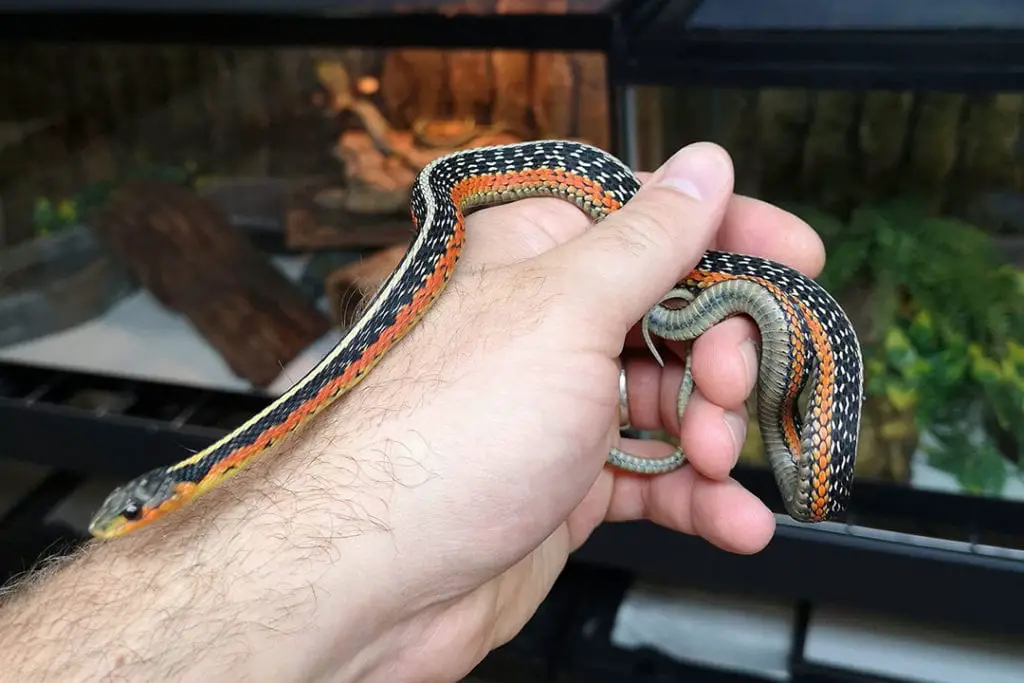
Adult garter snake size will depend on sex and species. Most species do not get over 3 feet long at their adult size (the garter snake’s average life span around 4 years). You want an enclosure that is as long as your snake with half its size for width and height.
This is a great option for most garter snakes, and it will be comfortable as your snake grows. To house multiple garter snakes (possible with this species), you would need something bigger.
It locks and has plenty of space for most species. Be sure that any enclosure you use has no gaps since most garter snakes are slender and good at sneaking out.
Substrate
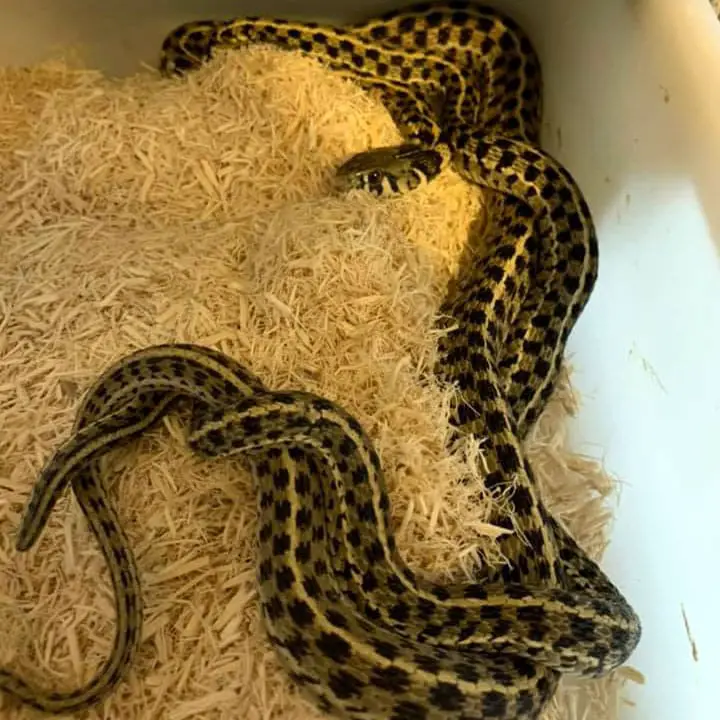
You can use paper towels for new snakes, but many garter snakes love to burrow so you should look for a substrate that will allow your snake to burrow.
Aspen is a great choice for most garter snakes. It can allow burrowing and is easy to take out and replace. You can also opt for other substrates like reptile bark, Reptichip or Eco earth. Coconut bedding is also fine. Be sure you never use any pine or cedar. Aromatic woods are toxic to snakes.
Heating
Snakes are cold-blooded animals. They need access to a temperature gradient to control their internal temperature.
Having the right temperatures is essential so your snake has a healthy immune system and allows your snake to digest properly.
What is the correct temperature gradient for a garter snake?
Garter snakes need a temperature of about 85 degrees Fahrenheit in the basking area and no less than 75 degrees on the cold side.
Heat mats work well for garter snakes but always plug them into a thermostat for safety.
You can also use a ceramic heating bulb but they can lower humidity. If you have a thick substrate this might help keep air temperatures up.
Always monitor with a digital thermometer that can measure the air temperature on each side. Use a heat gun to check the surface temperatures regularly.
Getting the temperature gradient right is critical for any snake species, as they need to use their environment to regulate their body temperature.
You can use a basking lamp for supplemental heating if needed, just make sure the snake cannot come directly into contact with the heating element.
Light
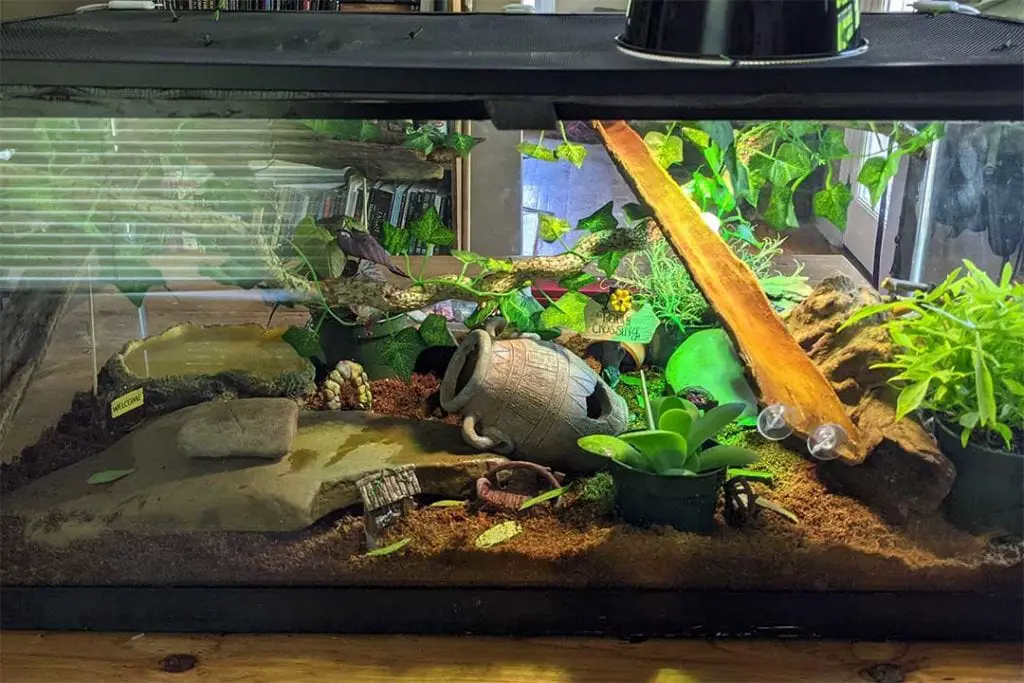
Snakes do not require special lighting to be healthy. However, a full spectrum bulb may help prevent a garter snake from wanting to brumate.
Changing light levels is one of the big triggers for starting brumation. If you cannot properly cool your snake, keeping a full spectrum light on a timer can help trick your snake into thinking it is always summer.
Make sure you turn any lighting off at night. You can also use standard lighting if you don’t want to offer UVB. Just keep it on a timer, 12 hours on is fine.
Shelter
Garter snakes need to feel secure to be happy. If your snake is kept in a barren enclosure, it will likely stay in the hide and never get any exercise.
Hides should be offered on both sides of the temperature gradient with more hiding places offered throughout the tank. Bark over deep substrate works as well as areas of thick greenery.
Any hide boxes should have one entrance and should be snug enough that the snake touches the sides of the hide. Your while snake should fit. If you see your snake leaving parts of its body out, you may need to offer a larger hide.
This is a great option for a hide and it has the benefit of making a great humid hide.
Water
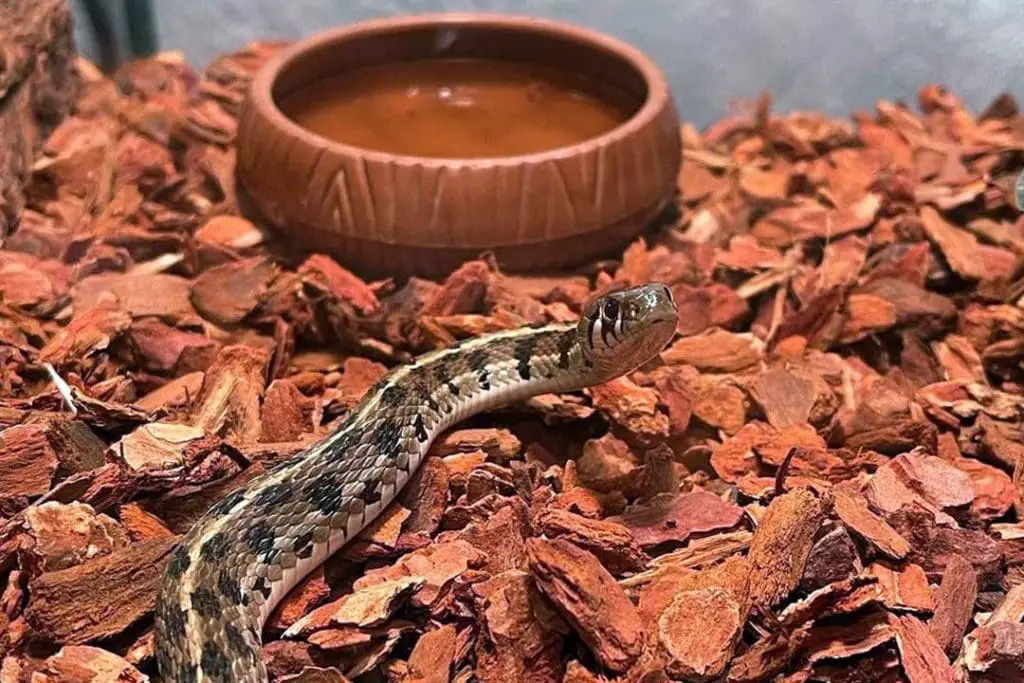
Many garter snake species love water. They can be amazing swimmers. Garter snakes frequently eat animals that live at the edge of the water like frogs or even aquatic animals like fish.
They need a large and wide water dish that will fit the whole snake. This helps control humidity and offers your snake important enrichment. Get a large and heavy dish that is wide and shallow.
This will allow your snake to soak or swim if it would like. This is a great option for a young snake, but you will need to size up for adults. Be sure you pick something easy to sanitize. Always provide chlorine free water.
Humidity
Humidity helps prevent dehydration and shedding problems.
What is the required humidity for garter snakes?
Garter snakes need a humidity of about 40-50% in their enclosure. You can raise it to 65% during shedding cycles.
Spraying a little bit of water inside the tank will help raise the humlidity if needed. If it’s too high, check that there is enough ventilation.
Enclosure Maintenance
Since garter snakes have a higher metabolism than many other snakes you need to keep up on cleaning and maintenance.
You should be replacing the snake’s water bowl daily and cleaning up any waste every day. Be sure to remove and replace any soiled substrate.
If your snake defecates in the water dish, be sure to completely sanitize the dish before replacing it. You should be replacing all of the substrate and sanitizing the enclosure monthly. The first step is to remove your snake and place it in a secure temporary enclosure.
This can be a tub with a locking lid and ventilation holes. Once your snake is out, turn off any heating and lighting. Take this time to remove all of the decorations and hides inside your snake’s tank.
Set these aside to be sanitized or toss out anything that can’t be properly cleaned.
Next, remove and dispose of the soiled substrate and scrub down the whole enclosure with a reptile-safe sanitizer. Make sure you rinse and dry thoroughly and leave the enclosure open to let it fully dry and air out.
Take this time to clean the hides and water dish and gather anything you will be adding to the enclosure. Once everything is dry, you can add a new layer of the substrate at least an inch thick.
Then, you can replace the decorations, hides, and water dish. Once this is done, you can turn on the heat mat or heating system and lighting and put your snake back. Be sure to lock up and make sure any ventilation or screens are locked down.
Feeding
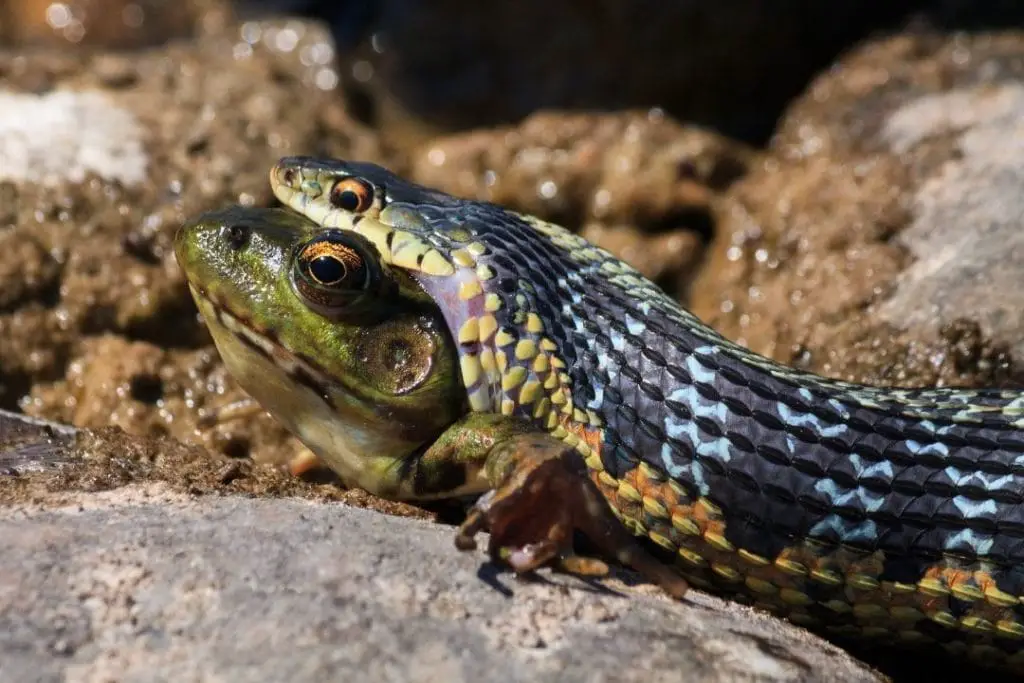
Garter snakes in the wild are so widespread because they have a very wide and varied diet diet. They are not constrictors so they eat anything they can overpower.
This includes worms, fish, amphibians, lizards, and small rodents. Many garter snakes will also eat frog or fish eggs if they have the chance.
This is one of the best snake species to keep if you do not like the idea of feeding rodents. However, care needs to be taken when selecting food for any garter snake.
Some species may prefer certain prey, and some prey offered in pet stores are dangerous to garter snakes.
Type and Size of Prey
Here is one of the big sticking points for captive bred garter snakes. Diet can be difficult and will likely depend on the exact species.
The best diet for any garter snake is mice. If you can get your snake onto mice, it will have complete nutrition.
By offering frozen and thawed mice, you do not need to worry about the parasites that plague most of the other prey options for garter snakes.
Babies frequently need cut-up pinky mice, but if you can stomach it this is the best diet in the long term. Remember to never feed anything larger than the widest part of your snake’s body.
Rodents aren’t a common food source in the wild, so you may need to scent mice to convince your snake to eat mice. If your baby is too small to eat pinky mice or you do not want to cut up pinkies, use worms and fish until you can switch.
If your snake will not take mice or you picked a garter snake to avoid feeding rodents, you have a few options depending on the exact species.
If you are not feeding mice, be sure to offer multiple types of food. This will make sure your snake gets all the nutrients it needs. Most baby garter snakes love worms.
Earthworms and nightcrawlers are some of the best options for garter snakes. Nightcrawlers need to be cut up so the worm can’t escape your snake.
Quarters are fine for most snakes, do not cut it up too small or your snake may ignore it. Never feed red wigglers, since these are toxic.
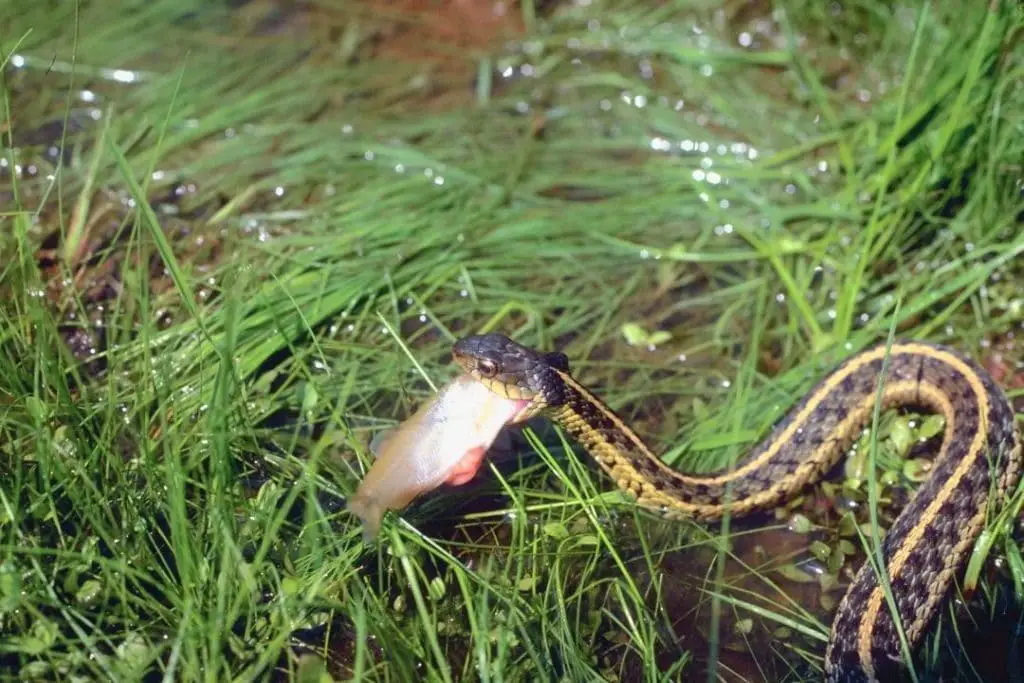
Fish are another option for garter snake food. Many species of garter snake feed on fish in the wild and many garter snakes will only take fish for food.
Live fish do have parasites, so be cautious. Only feed guppies or platys. Other common feeder fish like goldfish will harm your snake.
Frozen fish fillets can work well for garter snakes if you can convince your snake to take them.
You will need to supplement with calcium and vitamins. If you can access whole fish like from a fish farm, you can blend them up and use gelatin to create a more complete fish meal.
Freeze this and you have a good way to feed whole fish without risking parasites. Trout works well, but make sure any fish you feed whether live or as filets do not contain thiaminase.
Frogs and other amphibians are the most natural diet for garter snakes, but they have a high parasite load and are difficult to find.
You can use a product called frog juice to scent other prey types if your snake is refusing anything but amphibians. Be sure to add calcium to your snake’s diet if they eat worms or fish filets primarily.
You only need to do this about once a month. You can use powdered or liquid supplements.
Worms may be killed by calcium dust so be sure you only dust lightly rather than dredge the worms and make sure you offer the worm immediately after dusting.
Some species will also eat slugs or newts, but it can be hard to find these prey items. Amphibians and reptiles can be prey but they have heavy parasite loads.
Frozen Vs Live

If you decide to feed rodents, they should never be offered live if they can fight back. Garter snakes eat prey without constricting it.
They rely on a mild neurotoxic venom that may not work very well on rodents.
An adult rodent will be too strong for a garter snake to take out even if the rodent is the right size for your snake. Live nightcrawlers are fine, but be careful about what species you buy.
There is one referred to as a red wiggler that is intensely toxic to garter snakes. If you feed these, your snake will likely regurgitate. It will die if it manages to keep it down. You should also be careful with live feeder fish.
Some like goldfish contain thiaminase.
This breaks down thiamin. If your snake eats primarily fish containing thiaminase, it will eventually die of vitamin deficiency.
If you want to feed fish, be sure to do your research and know exactly what species your feeder fish are.
Frozen and thawed prey is great for captive bred garter snakes, but if they only want live prey, be sure you know it is safe. You can order many frozen rodents prey items for garter snakes like rodents online.
Live rodents can’t be shipped, and fish may not survive transport. Freezing is a great way to kill parasites if you feed fish. Fish fillets from safe species work great if you can convince your snake to take it.
How Often to Feed
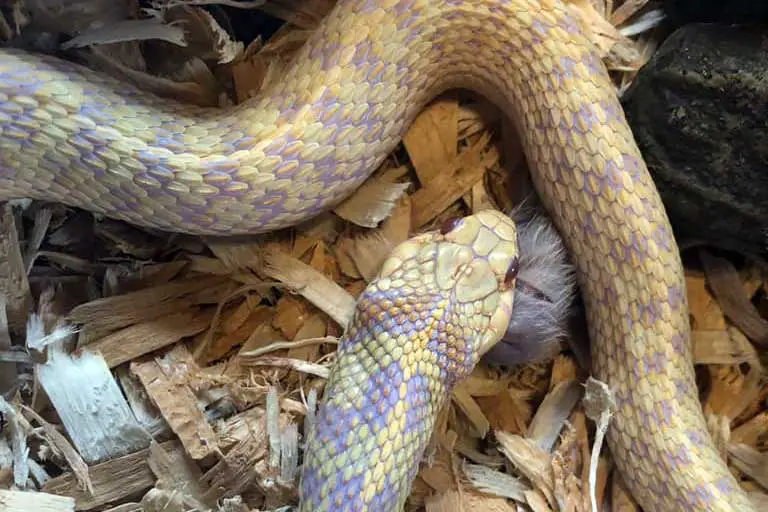
How often you need to feed your snake will depend on the age of your snake and its primary diet. If you are feeding worms to a baby snake, it will need to eat every other day. An adult on mice may eat every 7-10 days.
For an adult, feed worms twice a week, fish every 5 or 6 days, and mice every 7-10 days. Babies eat more frequently. You should monitor your snake’s weight and body condition and adjust the feeding schedule to keep them growing steadily.
If you vary your snake’s diet, you can stick to a medium schedule for the food types unless your snake is very young. Most snakes can handle some hunger but babies need to eat very often.
Amounts depend on the size of the snake. The goal is to have a small bulge in the snake without overwhelming it. A baby may eat about a third or quarter of a nightcrawler.
They may also take a quarter to half of a mouse pinky or a few feeder guppies. If you feed fish filets or the blended trout diet you should offer a piece around the size of half a pinky.
Aim for smaller and more frequent meals with captive bred garter snakes particularly when young. Meals can size up with your snake. Just watch how they react and you will figure out the right schedule for your snake.
Shedding
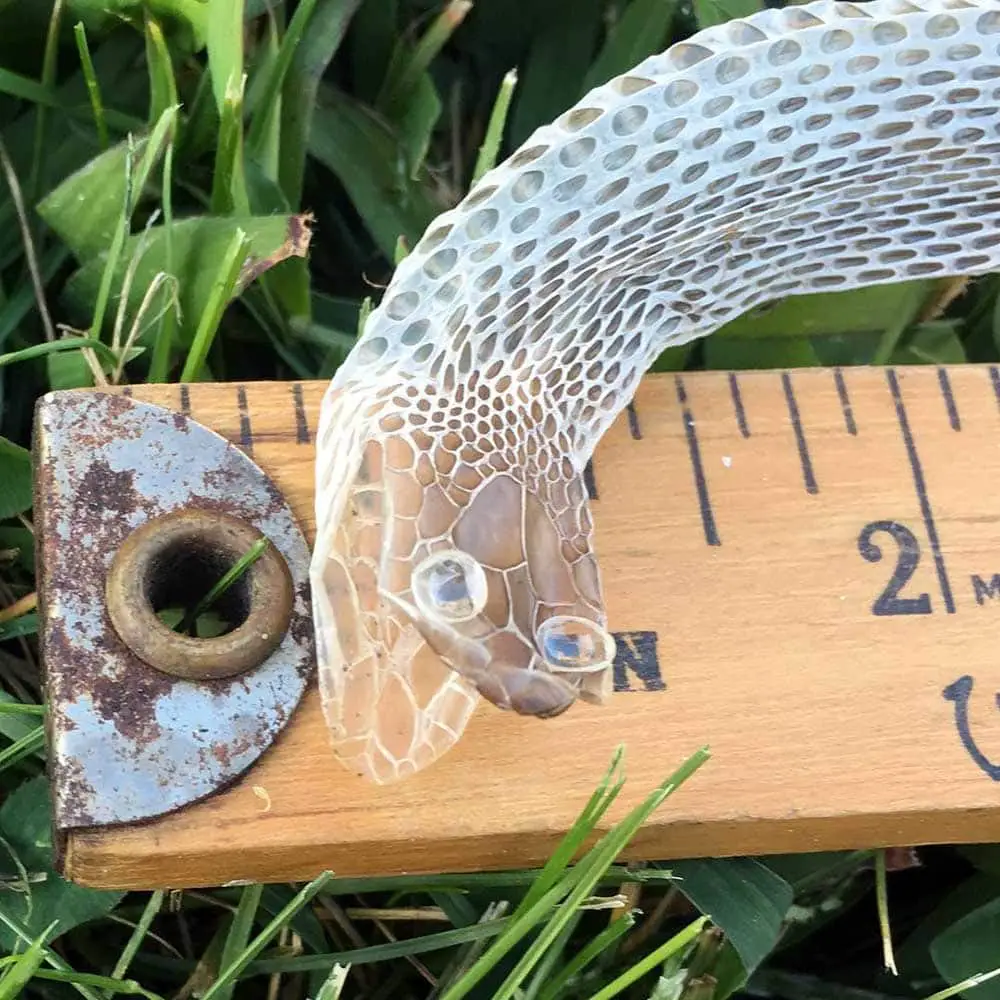
All snakes need to shed. This allows them to grow and helps heal injuries and damage to the skin and scales.
Your garter snake needs high humidity to help its old skin come off in one piece. If any of the skin is retained, your snake may be injured or suffer from infections.
The biggest sticking points are the eye caps that protect the eye itself and the tip of the tail. Up your humidity when your snake starts showing signs of shedding like dull colors or cloudy eyes.
You should also offer a humid hide filled with damp sphagnum moss on the warm side of the enclosure.
If you notice that your snake hasn’t shed all of its skin, you can put it in a container with a warm, damp paper towel. Leave your snake for about half an hour and try to gently remove the stuck skin.
Hibernation
Hibernation is called brumation in reptiles. During this time, garter snakes will head to a communal den and slow down. They are technically awake, but their metabolism drops immensely.
You only need to brumate your snake if you intend to breed it or it decides it wants to brumate.
The changing light levels in the fall can make your snake refuse to eat in preparation for brumation. If this happens, you will need to brumate your snake so it doesn’t lose too much weight during the winter.
Sometimes you can use full-spectrum lighting and raise the heat to help stop your snake from brumating, but if you cannot you will need to brumate the snake properly.
You will need to stop feeding and make sure your garter snake has defecated. This can be encouraged with a lukewarm bath. Then, you can gradually drop the temperatures to between 47-55 degrees. Make sure the snake has access to water and check on it at least once a week until spring arrives.
Once spring arrives, slowly raise the temperature back to room temperature and then turn back on the heating and get it back to normal temperatures.
Your garter snake should be interested in food within a week of being warmed up. Be slow and careful so you don’t shock your snake.
Handling
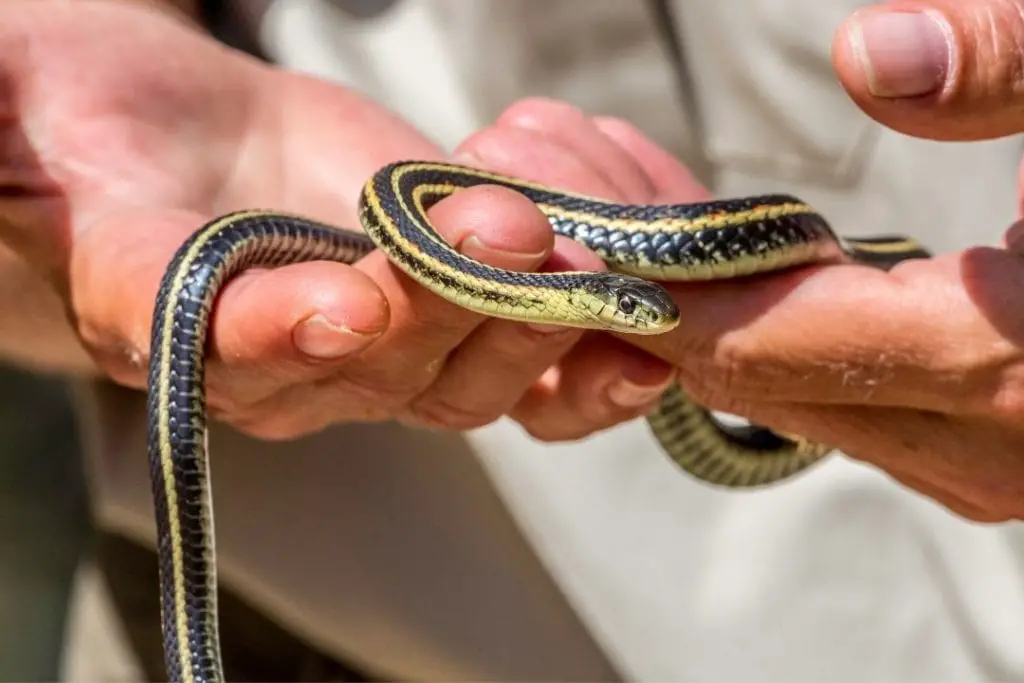
The first thing to note about common garter snakes is that they do have mild venom. It cannot hurt humans since it is too mild and they do not have a good method for delivering venom to anything large.
At worst you may experience swelling and pain from a bite. Keep this in mind when handling your snake and treating any bites.
Always support your snake fully since they can’t hang on and wear gloves since babies may musk you.
Be gentle and lift your snake from underneath. Babies can nip but they should settle down in time. Otherwise, garter snakes are calm and can be handled like other species.
Common Issues
This section will go over some common concerns with common garter snakes. If your question isn’t answered here, be sure to ask in the comments below.
My Garter Snake isn’t Eating
Stress and the wrong prey type are the single biggest reasons your garter snake may refuse to eat. If your snake misses two meals and seems otherwise healthy, try leaving your snake alone to relax.
You can offer another meal after a week of letting your snake relax. Do not handle your snake and make sure the enclosure is in a quiet location.
You should also make sure you have plenty of hiding spots. Some snakes will also be picky about prey.
Look up what your exact garter snake species eats and ask the breeder what the snake was eating if you just got it. Illness is another factor, so keep an eye on your snake.
Regurgitation
Regurgitation is very worrying in garter snakes.
The biggest reason is that you are feeding something too large for your snake. The other reason is that you are feeding toxic prey. If you are feeding worms, be sure the species you are feeding your snake isn’t toxic.
Common Health Problems
Since garter snakes love water, they are at risk of skin infections from too much moisture. Keep an eye on humidity levels. You may also see mouth infections or respiratory infections.
If you see excess mucus, pus, blood, or hear any strange sounds while your snake is breathing, take it to the vet immediately. Parasites and skin blisters (blister disease) are also a common concern.
External parasites like ticks are easy to notice on your snake. Mites look like black specks about the size of a poppy seed.
Check the water for them since your snake will try to soak to kill them. Internal parasites can sicken or kill your snake, and will spread easily if you own multiple garter snakes. Have fecal tests if you notice any changes or a loss of appetite.
Sources
- Cold-Blooded, but Not Cold-Hearted, Garter Snakes Form Friendships
- GARTER SNAKE POPULATION DYNAMICS FROM A 16-YEAR STUDY
- The Gartersnake Research Project
- Some Aspects of the Ecology of the Eastern Garter Snake (Thamnophis sirtalis sirtalis) in a Semi-Disturbed Habitat in West-Central Illinois
- Aggregation and social interaction in garter snakes (Thamnophis sirtalis sirtalis)
Thamnophis Subspecies
You can find a lot of different types of garter snakes, including various color morphs. The subspecies of Thamnophis Sirtalis Snakes (Garter Snake) are:
- Thamnophis sirtalis concinnus (Hallowell, 1852) – Red-spotted Garter Snake, Red-spotted Gartersnake
- Thamnophis sirtalis dorsalis (Baird and Girard, 1853) – New Mexico Garter Snake, New Mexico Gartersnake
- Thamnophis sirtalis fitchi Fox, 1951 – Valley Garter Snake, Valley Gartersnake
- Thamnophis sirtalis infernalis (Blainville, 1835) – California Red-sided Garter Snake, California Red-sided Gartersnake
- Thamnophis sirtalis lowei Tanner, 1988
- Thamnophis sirtalis pallidulus Allen, 1899 – Maritime Garter Snake
- Thamnophis sirtalis parietalis (Say in James, 1823) – Red-sided Garter Snake, Red-sided Gartersnake
- Thamnophis sirtalis pickeringii (Baird and Girard, 1853) – Puget Sound Garter Snake, Puget Sound Gartersnake
- Thamnophis sirtalis semifasciatus (Cope, 1892) – Chicago Garter Snake, Chicago Gartersnake
- Thamnophis sirtalis similis Rossman, 1965 – Blue-striped Garter Snake, Bluestripe Garter Snake, Blue-striped Gartersnake
- Thamnophis sirtalis sirtalis (Linnaeus, 1758) – Eastern Garter Snake, Eastern Gartersnake
- Thamnophis sirtalis tetrataenia (Cope in Yarrow, 1875) – San Francisco Garter Snake, San Francisco Gartersnake
Conclusion
Garter snakes (Including the ribbon snakes subspecies) are great if you want a small snake that can eat something other than rodents. Take good care of them and you may have your snake with you for many years to come. If you have any questions or comments, please leave them below.
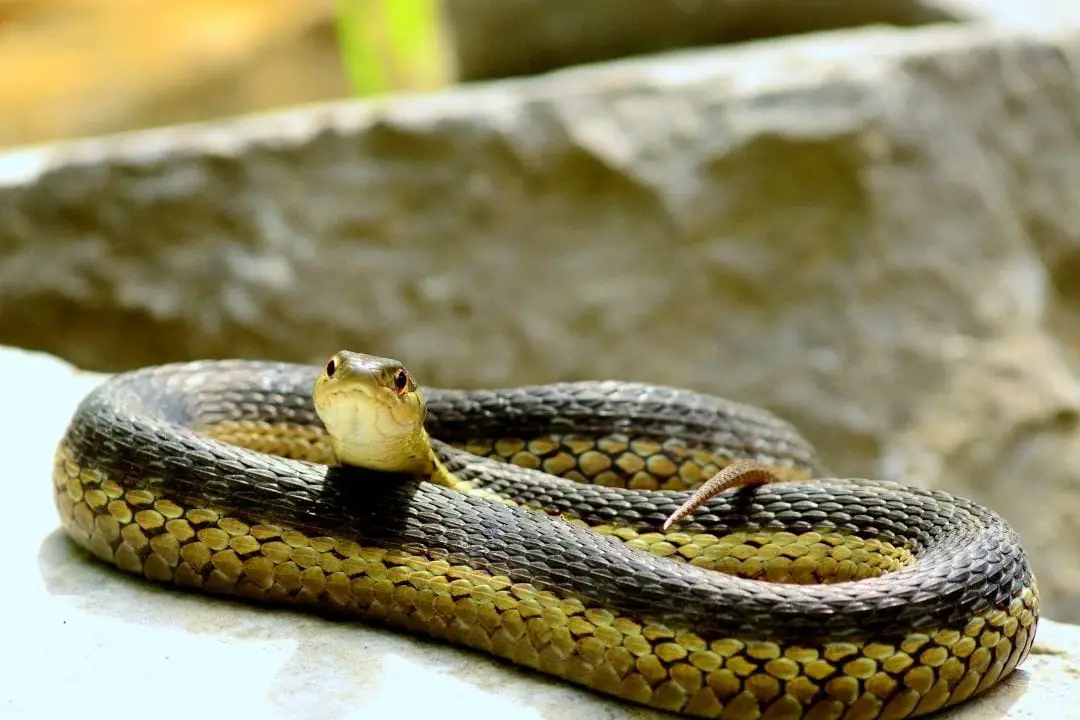
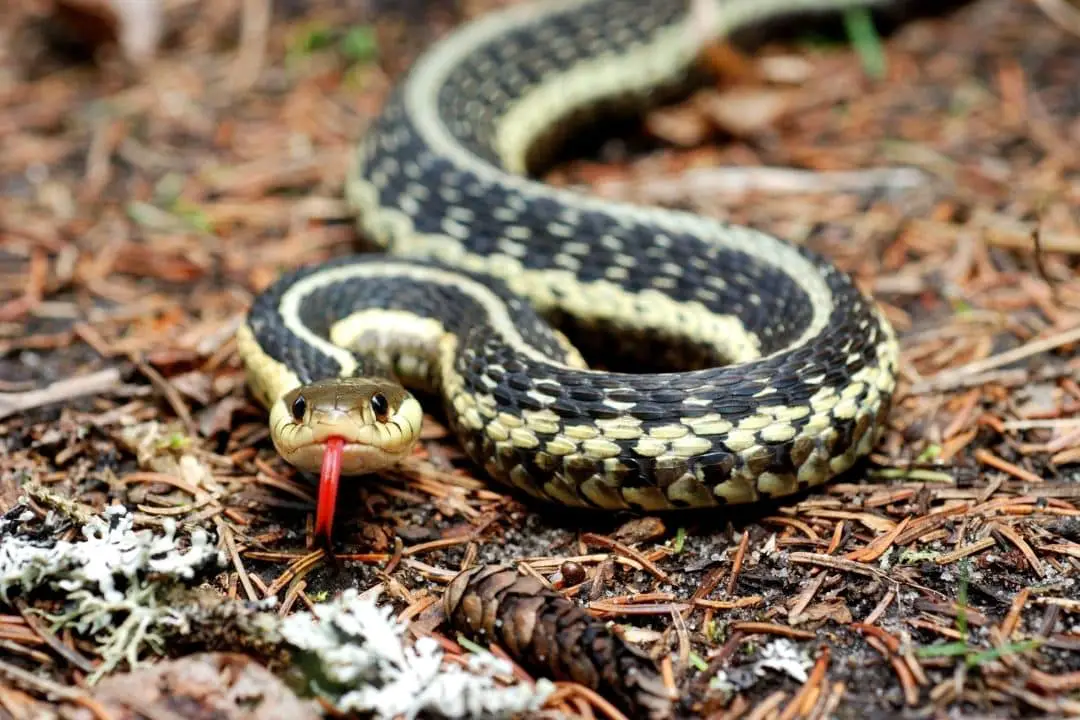
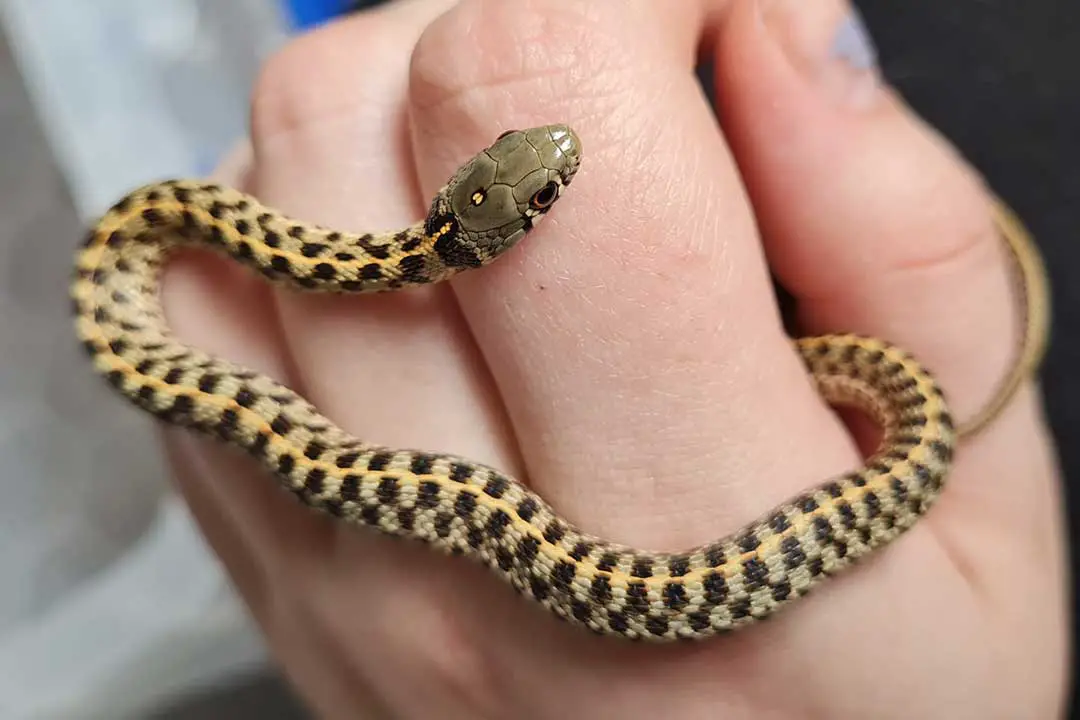
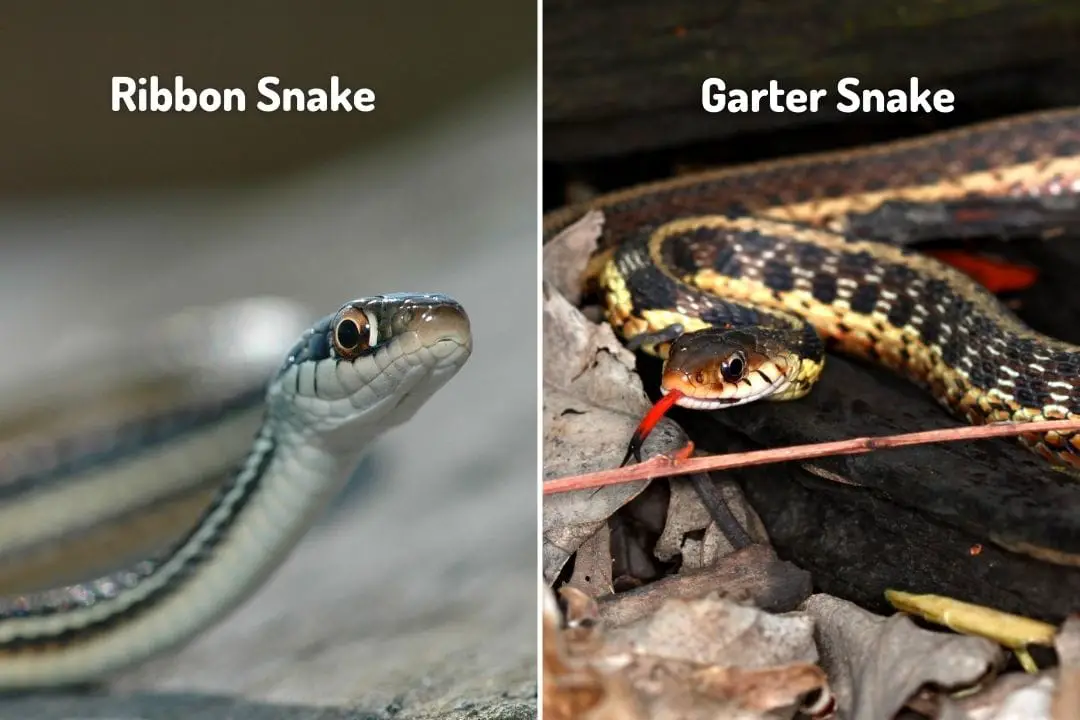

I found a wild baby garter snake in someone’s back yard. Plus I’ve never owned a snake in my life. I’ve had it for about 2 weeks. I’ve tried small pieces of chicken, crappie fish, wax worms and baloney. As I read articles saying to guess food type. But wild baby garter snake won’t eat anything. I had lights but didn’t create enough heat. Just added a line of back yard lights. Which created heat of 80 degrees. Snake is loving heat.
So how can I get him to eat.